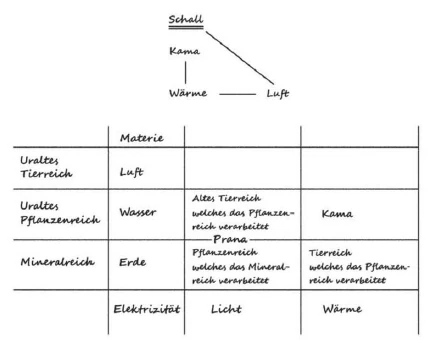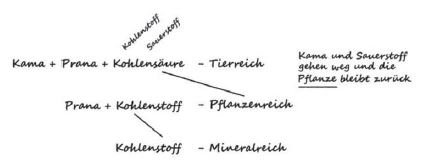Man, Nature and the Cosmos
GA 91
29 August 1905, Berlin
Translated by Steiner Online Library
22. The Relationship Between the Natural and Etheric Realms
Certainly the present materialistic doctrine of evolution tells us that from the mineral kingdom the plant kingdom, the animal kingdom, the human kingdom arose. According to the theosophical teaching, the original is man. He has separated from himself first the animal kingdom, the plant kingdom and the mineral kingdom. In these three kingdoms we can see it best.
In the coal deposit we meet the burning coal; it was a plant millions of years ago. The huge primeval forests that covered the earth had trees similar to ferns and horsetails. They first buried themselves in themselves. The solid ground has originated from the plant, in that it formed the earth ground as coal solidified. Our whole mineral world we would be able to follow, if we go on, up to the plant world. The rocks are nothing else than corpses of ancient plants, and our present coal would change after millions of years to other rock. So that the basic substance of all minerals is coal. Coal is plant body and original substance of all mineral. What is it, then, that actually makes all other minerals out of coal? What force is it?
It is a force which really pervades the whole mineral world, namely the electric force which rests, as it were, locked in all mineral and which can be called forth. And what has made the various minerals out of coal is precisely the electric force.
What actually causes the plant to become a mineral, a coal? What goes away from the plant? Prana - the life principle goes away. If we take it away from it and instead give electricity to the carbon, if we replace the life ether with electrical or chemical ether, then we get mineral.
If we go up still further, there is no vegetable kingdom on earth either, but only an animal kingdom; and the vegetable kingdom is born out of the animal kingdom just as coal and rock are born out of the vegetable kingdom. What did this animal kingdom contain at that time? It was a kingdom which consisted of a different substance than the present one. It was air animals. This ancient animal kingdom mixed air with prana and also with kama, and this air was carbonic acid. That which we find today in certain seltzer waters, these air bubbles, was the matter of which the animals were composed. Kama, Prana and carbonic acid, that resulted in our ancient animal kingdom. Carbonic acid consists of carbon and oxygen. At the moment when oxygen is released from the animal, it retains only carbon and sinks into the plant kingdom. And what happened to Kama? It draws the oxygen; as we know, it causes the blood circulation. Thus we have a certain cycle from the aerial animal to the plant and to the mineral. In those ancient times, where there was no human kingdom, the plant was an aquatic being, so we have to distinguish:
- First: an ancient animal kingdom in the air, interwoven,
- second: with an ancient plant kingdom whose matter was liquid carbon, that is, water, and
- thirdly: the mineral kingdom - earth, solid matter.
Now, however, these kingdoms still remain in their descendants. When the ancient animal kingdom was there alone, it did not need first to bring up external substance. But now, when the plant kingdom arose, it had to draw substances out of the plants in order to nourish itself. So that the animal kingdom ceases to be the only kingdom, it is dependent on the kingdom next to it. So it is the ancient animal kingdom that draws its nourishment from the plant kingdom.
Then we get a plant kingdom which processes the mineral kingdom. This is always done with the help of another. In the mineral kingdom, the animal kingdom processes the plant kingdom with the help of heat. The plant kingdom processes the mineral kingdom with the help of light, and our mineral kingdom processes electricity.
The ancient animal kingdom did not yet have heat, but had within it the power of kama. This is connected with the animal kingdom also now, but not with substance, but with heat. With the plant, in the connection with the light, there is the prana. In a certain respect heat and kama have entered into looser connection by the fact that something has come between them. If we go back from the air, we think of this connection becoming still looser; if we come back from the heat into the air, we have not kama penetrating the air, but sound, and thus we come to man. Originally the word - word-sound - then man has gone through all the kingdoms until he returns and becomes again the ruler of sound.


22. Die Naturreiche und Ihr Verhältnis zu den Ätherarten
Gewiss sagt uns die heutige materialistische Entwicklungslehre, dass aus dem Mineralreich das Pflanzenreich, das Tierreich, das Menschenreich entstanden ist. Nach der theosophischen Lehre ist das Ursprüngliche der Mensch. Er hat von sich abgegliedert zunächst Tier-, Pflanzen- und Mineralreich. An diesen drei Reichen können wir es am besten sehen.
Im Kohlenlager treffen wir die Brennkohle an; sie war vor Millionen Jahren Pflanze. Die riesigen Urwälder, welche die Erde bedeckten, hatten Bäume ähnlich den Farnen und Schachtelhalmen. Die haben zunächst sich in sich selbst begraben. Der feste Boden ist entstanden aus der Pflanze, indem er als Kohle festgebacken den Erdengrund bildete. Unsere ganze mineralische Welt würden wir, wenn wir weitergehen, bis zur Pflanzenwelt verfolgen können. Die Felsen sind nichts anderes als Leichname uralter Pflanzen, und unsere heutige Kohle würde sich nach Millionen von Jahren zu anderem Gestein verwandeln. Sodass die Grundsubstanz aller Mineralien Kohle ist. Kohle ist Pflanzenleib und Urstoff alles Minerals. Was ist es denn eigentlich, was aus der Kohle alle übrigen Minerale macht? Welche Kraft ist es?
Es ist eine Kraft, die wirklich die ganze mineralische Welt durchdringt, nämlich die elektrische Kraft, die gleichsam verschlossen in allem Mineral ruht und die hervorgerufen werden kann. Und was aus der Kohle die verschiedenen Mineralien gemacht hat, ist eben die elektrische Kraft.
Was bewirkt denn eigentlich, dass die Pflanze zum Mineral, zur Kohle werden kann? Was geht aus der Pflanze fort? Prana — das Lebensprinzip geht fort. Wenn wir es ihr entziehen und stattdessen dem Kohlenstoffe die Elektrizität geben, wenn wir den Lebensäther ersetzen durch elektrischen oder chemischen Äther, dann bekommen wir Mineralisches.
Wenn wir noch weiter hinaufsteigen, gibt es auf Erden auch kein Pflanzenreich, sondern nur ein Tierreich; und das Pflanzenreich ist ebenso herausgeboren aus dem Tierreich wie Kohle und Gestein aus dem Pflanzenreich. Was hat dieses Tierreich damals enthalten? Es war ein Reich, welches aus einem anderen Stoff bestand als das heutige. Es waren Lufttiere. Dieses uralte Tierreich hat Luft mit Prana vermischt und außerdem mit Kama, und zwar war diese Luft Kohlensäure. Das, was wir heute in gewissen Selterswassern vorfinden, diese Luftbläschen, war die Materie, aus der die Tiere bestanden. Kama, Prana und Kohlensäure, das ergab unser uraltes Tierreich. Kohlensäure besteht aus Kohlenstoff und Sauerstoff. In dem Augenblick, wo vom Tiere der Sauerstoff abgegeben wird, behält es nur Kohlenstoff und sinkt ins Pflanzenreich. Und was geschah mit Kama? Es zieht den Sauerstoff heran; wie wir wissen, bewirkt es die Blutzirkulation. Somit haben wir einen gewissen Kreislauf vom luftförmigen Tier zur Pflanze und zum Mineral. In diesen uralten Zeiten, wo es kein Menschenreich gab, war die Pflanze ein Wasserwesen, sodass wir zu unterscheiden haben:
- Erstens: ein uraltes Tierreich in der Luft, verwoben,
- zweitens: mit einem uralten Pflanzenreich, dessen Materie flüs siger Kohlenstoff war, also Wasser, und
- drittens: das Mineralreich — Erde, fester Stoff.
Nun bleiben aber diese Reiche in ihren Nachkommen noch vorhanden. Als das uralte Tierreich allein da war, brauchte es nicht erst äußerlichen Stoff heranzuziehen. Jetzt aber, wo das Pflanzenreich entstand, musste es aus den Pflanzen Stoffe herausziehen, um sich zu ernähren. Damit das Tierreich gleichsam aufhöre, alleiniges Reich zu sein, wird es auf das Reich neben ihm angewiesen. Es ist also das alte Tierreich, das seine Nahrung aus dem Pflanzenreich zieht.
Dann erhalten wir ein Pflanzenreich, welches das Mineralreich verarbeitet. Dies geschieht immer mit Hilfe eines anderen. Das Tierreich verarbeitet im Mineralreich das Pflanzenreich mit Hilfe der Wärme. Das Pflanzenreich verarbeitet das Mineralreich mit Hilfe des Lichts, und unser Mineralreich verarbeitet die Elektrizität.
Das uralte Tierreich hatte noch keine Wärme, hatte aber in sich die Kraft des Kama. Dies ist mit dem Tierreich auch jetzt verbunden, aber nicht mit der Substanz, sondern mit der Wärme. Bei der Pflanze ist in der Verbindung mit dem Lichte das Prana. In einer gewissen Beziehung sind Wärme und Kama in losere Verbindung getreten dadurch, dass etwas zwischen sie getreten ist. Wenn wir von der Luft zurückgehen, denken wir uns diese Verbindung noch loser werdend; kommen wir von der Wärme in die Luft zurück, haben wir nicht Kama, das die Luft durchdringt, sondern den Schall, und somit kommen wir zum Menschen. Ursprünglich war das Wort — Wort-Schall —, dann hat der Mensch alle Reiche durchgemacht, bis er zurückkehrt und wieder zum Herrscher des Schalls wird,



